Photojournalism and Ethics
Discover the ethical considerations of photo manipulation in photojournalism. Learn about acceptable and unethical techniques and their impact on credibility.
⚡ Photojournalism and Ethics
In the age of social media and digital news, photographs are powerful tools that can shape opinions and move the public discourse. So, let’s talk here about photojournalism and ethics.
With the click of a button, images circulate globally, underscoring the significance of authenticity and honesty in visual representation. As we discuss the intricacies of digital manipulation, it's crucial to recognize its impact on the credibility of photojournalism.
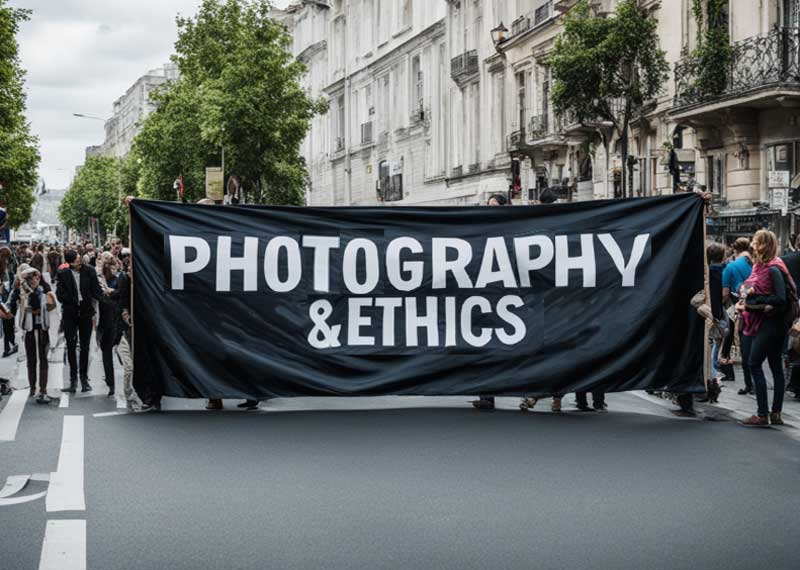
Ethical Considerations in Digital Manipulation: Photoshop and Photojournalism
The rules of photojournalism become paramount amidst the growing concerns over the integrity of digitally altered images.
So, I decided to write an essay about photojournalism and ethics which is an interesting topic. And, due to the complexity of the “Photojournalism Ethics” theme, I used an essay writer service to help me with my research.
⚡ What is Photojournalism?
Photojournalism is a form of journalism that uses images, typically photographs, to tell a news story or document events. Photojournalists capture and present visual narratives that convey information, emotions, and the essence of a story. These images are often used in newspapers, magazines, websites, and other media to accompany news articles and provide a visual context for current events.
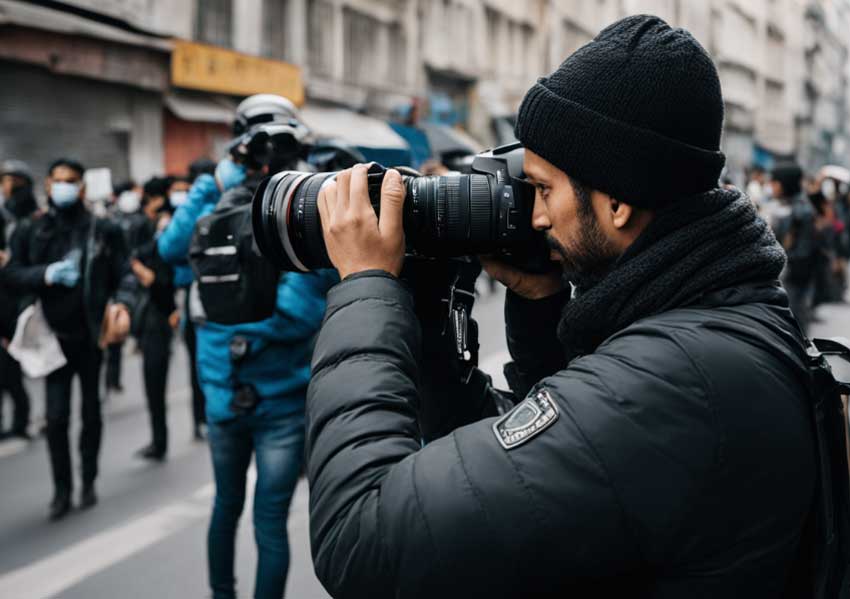
⚡ Importance of Photojournalism
Photojournalism is important for several reasons:
- Visual Storytelling: It provides a powerful and immediate way to convey information, emotions, and stories to a broad audience. It complements written journalism by providing a visual dimension that enhances readers' understanding of news stories.
- Awareness and Accountability: Through compelling images, it can raise awareness and inspire action on critical global issues like human rights, climate change, and social justice.It holds individuals, organizations, and governments accountable by shedding light on social, political, and humanitarian issues.
- Connection: It connects people across the world by showing common human experiences and challenges, fostering empathy and understanding.
⚡ The Importance of Ethics in Photojournalism
Ethics in photojournalism plays a pivotal role in the realm of journalism. Photojournalism and ethics are intertwined for several reasons that are listed below as a general guideline:
- Uphold the truth and ensure that the story being told is accurate.
- Maintain public trust in the media.
- Protect the reputation of journalistic outlets.
- Preserve the integrity of historical documentation.
- Prevent the manipulation of public emotion through misrepresented imagery.
- Respect for the subjects in the photographs and the broader societal context.
- Avoid legal consequences for both the photojournalist and the media outlet showcasing the photo.
⚡ 6 Ethics of Photojournalism
Photojournalism ethics guide the conduct of photographers in their pursuit of truth and accurate representation of events. Here are six core pillars of photojournalism ethics:
- Truthfulness: Truth is the cornerstone of photojournalism and ethical photography. The imagery must reflect what truly happened without alteration or misleading elements. This principle ensures that the story behind the photo remains honest and uncorrupted by personal or corporate agendas.
- Accuracy: Accuracy in photojournalism involves the precise depiction of events without exaggerating or downplaying the visual facts. It's not just about what you show but also about what you choose not to show, avoiding any bias that might mislead the viewer.
- Objectivity: Objectivity in photojournalism requires photojournalists to capture and present images without personal bias, allowing the viewer to draw their own conclusions from the unvarnished reality. This principle supports the idea that the camera, though operated by a human, should act as an impartial witness to events. They should refrain from staging or directing events to fit a particular narrative.
- Respect for Subjects: Photojournalists must respect the dignity and privacy of the individuals they photograph. They should be mindful of the potential impact of their images on the subjects and seek informed consent when appropriate, especially in sensitive or private situations.
- Avoiding Harm: Photojournalists should consider the potential harm their work may cause to individuals or communities. This includes both physical and emotional harm. Care should be taken to minimize any negative impact, particularly in cases involving victims of trauma or violence.
- Transparency: Photojournalists should be transparent about their methods and the context in which their images were captured. If alterations are made to an image, they should be clearly disclosed. Additionally, photojournalists should be accountable for the accuracy of their work and correct any errors promptly.
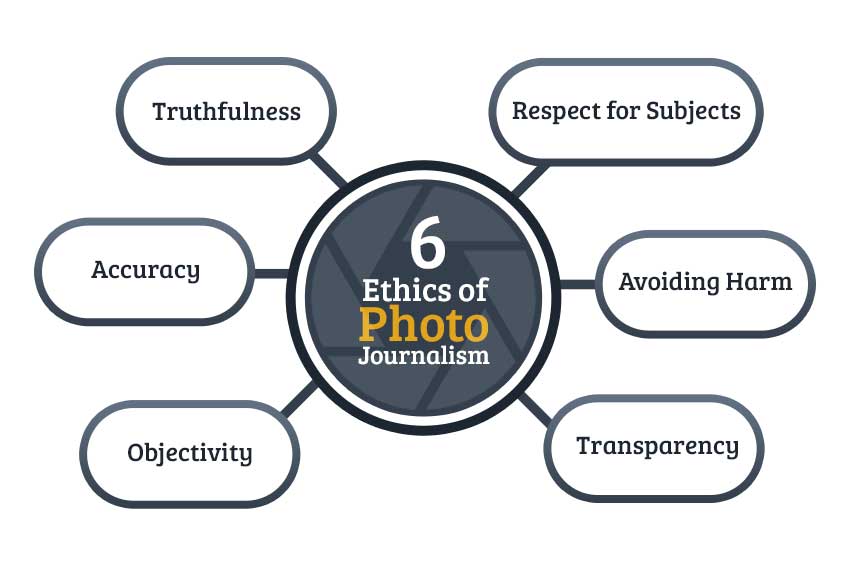
Every type of photography like sports photography, wildlife photography, street photography, fashion photography and so on, has its own ethics code. Read this article about how to be an ethical wildlife photographer to learn more interesting things.
⚡ The Growing Trend of Digital Manipulation in Photojournalism
Digital manipulation has evolved hand-in-hand with technology, from the darkroom trickery of the past to the sophisticated software of the present. Initially, the skill was rare, confined to experts who altered images for hours or even days.
Nowadays, Photoshop has spread photo editing, making it a standard skill for most photojournalists and hobbyists alike.
This ease of access has led to a significant increase in types of photo manipulation in journalism. Where once the integrity of a photograph was rarely questioned, today, there's a growing need for vigilance as even the most subtle changes can be made quickly and unnoticeably. A fake image detector is an useful tool for ethical photography as it can tell us if an image is photoshopped or not.
⚡ Defining Digital Manipulation in Photo Editing
Digital manipulation refers to altering photographic images using software like Photoshop, 🏆 the best photo editing tool.
There are other fake photo maker tools like Gimp, Photopea, MockoFun, or Canva that you can use. Read my article Canva vs Photoshop and find out more about these two tools.
Photo editing can range from basic adjustments, such as tweaking brightness or contrast, to more significant changes, like erasing objects or altering shapes, thus potentially altering the image's narrative or message.
Photoshop ethics apply not only to photojournalism but also to all kinds of other images that are publicly posted. But, the Photoshopped news photos remain the most dangerous examples.
⚡ Understanding Ethical Considerations in Digital Manipulation
When we talk about digital manipulation, we're looking at the delicate balance between enhancing a photograph and distorting the truth. This is especially critical in photojournalism, where pictures serve as a testament to events and carry a weight of authenticity. Ethical considerations come into play to ensure that the narrative told by an image is not misleading or fabricated.
Photoshop, a powerful tool in photo editing, can easily cause misrepresentation if not used responsibly. Photojournalists are tasked with maintaining integrity and presenting images that reflect what actually occurred. The ethical use of Photoshop is fundamental to preserving the trust between the public and the media.
⚡ Photo Editing Before Photoshop
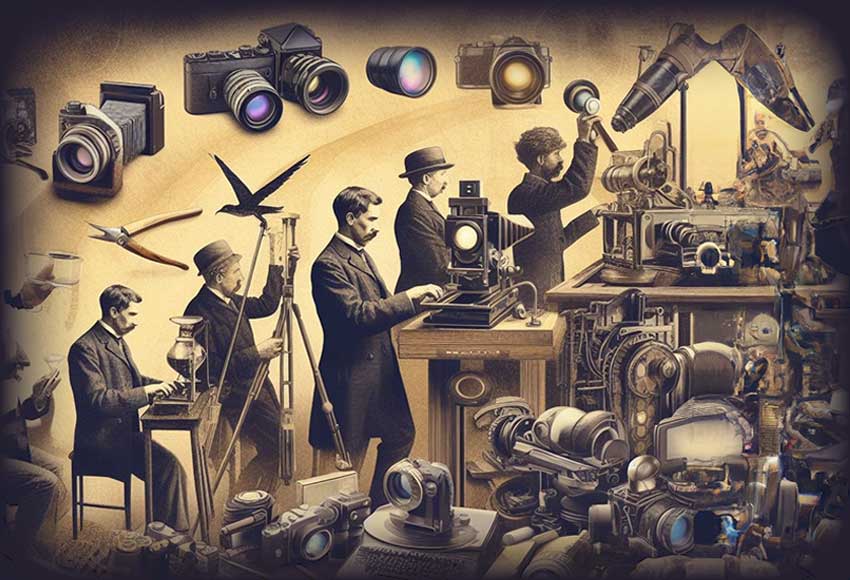
Before the era of digital photo editing software like Adobe Photoshop, photographers employed various traditional methods to enhance and manipulate images. Photoshop was brought to the public in 1990 and since then a lot of Photoshop versions were released.
Check the methods used to edit photos before Photoshop:
- Dodging and burning allowed for selective exposure control in the darkroom (this where old film photographs where developed).
- Chemical manipulation (another method used in the darkroom) altered the development process to modify contrast and tonality.
- Hand-tinting involved manually adding color to black and white prints.
- Composite printing combined multiple exposures on a single photographic paper.
- Airbrushing was a popular method for retouching where apply paint or dyes onto photographs, allowing them to touch up imperfections, alter colors, or hide blemishes on the print.
- Filters and lenses were used to achieve specific effects.
- Manual retouching with pencils or inks were used for imperfections.
- Physical cut and paste involved physically cutting out parts of a photograph and pasting them onto another surface or photograph.
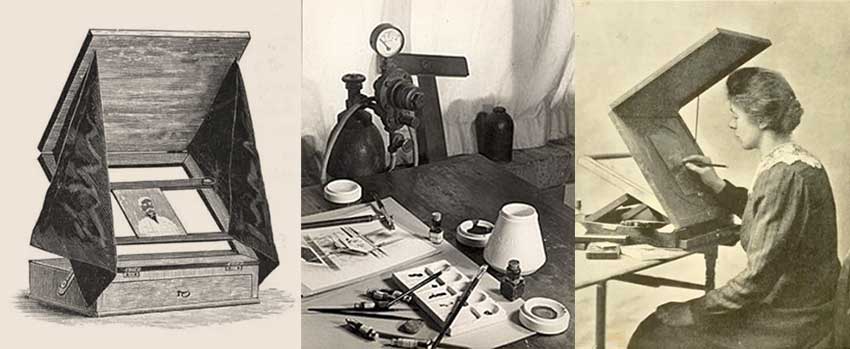
These methods required skill and precision, marking the historical evolution of photo editing before the digital age transformed the landscape with powerful and accessible software tools. Read more about the history of photo manipulation in this article.
⚡ Acceptable vs. Unethical Photo Manipulation
In photo editing, there's a fine line between acceptable enhancements and unethical manipulations. While some techniques aim to preserve the essence of a photograph, others can distort the truth beyond recognition.
⚡ Photojournalism Ethics: Acceptable Photo Manipulation
Associated press code of ethics for photojournalists (2023) states the following regarding photograph ethics:
AP images must always be accurate. We do not alter or digitally manipulate the content of a photo or video except as stated below.
We avoid the use of generic photos or video that could be mistaken for imagery photographed for the specific story at hand, or that could unfairly link people in the images to illicit activity. No element should be digitally altered except as described below. Minor adjustments to photos are acceptable. These photo adjustments include:
- ✔️ Cropping without altering the context;
- ✔️ Dodging and burning
- ✔️ Conversion into grayscale
- ✔️ Elimination of dust on camera sensors and scratches on scanned negatives or scanned prints.
- ✔️ Normal toning and color adjustments.
These should be limited to those minimally necessary for clear and accurate reproduction and that restore the authentic nature of the photograph.
- ❌ Changes in density, contrast, color and saturation levels that substantially alter the original scene are not acceptable.
- ❌ Backgrounds should not be digitally blurred or eliminated by burning down or by aggressive toning.
- ❌ The removal of “red eye” from photographs is not permissible.
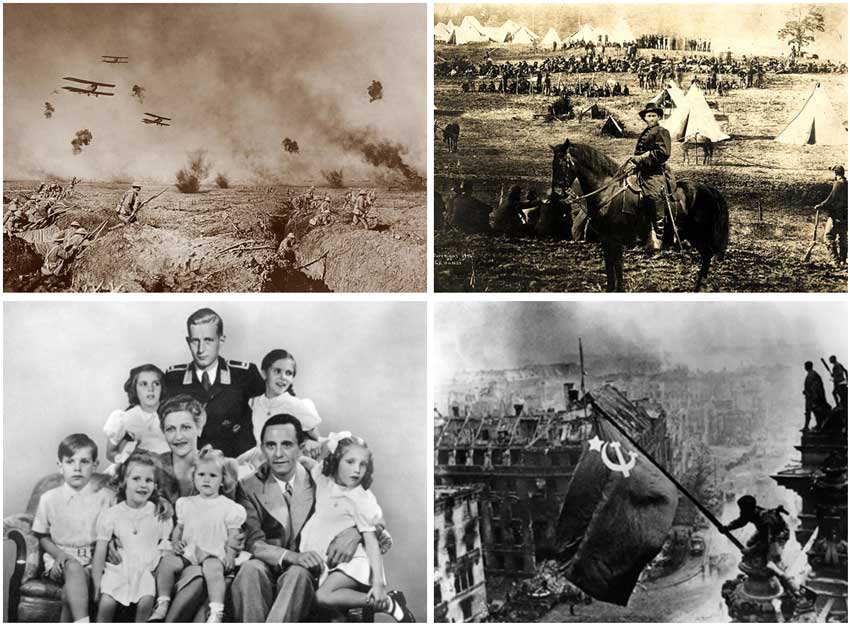
To sum up, I can say that these minor photo adjustments are ok to use in photojournalism photography:
- ✔️ Color Adjustments
- ✔️ Cropping without altering the context
- ✔️ Level adjustments
- ✔️ Sharpening
- ✔️ Noise reduction
❌ Photojournalism Ethics: Unethical Photo Manipulation Examples
Photojournalism has witnessed several high-profile controversies due to digital manipulation, raising ethical debates and challenging trust in visual media.
The Difference Between Photo Editing and Photo Manipulation
Photo editing aims to refine and enhance images by adjusting colors, contrast, and minor details to improve their quality while preserving the original context. These methods are usually accepted in photojournalism.
Photo manipulation involves more extensive alterations, often creating entirely new visual narratives by adding or removing elements, merging multiple images, or distorting reality to achieve artistic or deceptive effects, departing significantly from the original context or intent of the image. These methods are NOT accepted in photojournalism.
😠 Ethics of Photojournalism: Case Studies of Unethical Photo Manipulation
There are lots of cases of famous Photoshopped images and famous fake photographs in the media. Below you have a list of unethical photojournalism examples and I explain the photo manipulation technique that was used for each example.
There are other photo hoaxes more impressive than these. I’ve chosen these because in each of these misleading pictures another method was used.
1. Adding or Removing Elements (objects, people, etc.) to Create a Misleading Context 👎
The first photo on my list of fake news pictures examples is the one in which the Romanian communist leader Nicolae Ceausescu welcomes the president Valéry Giscard d'Estaing at Bucharest in March 1979.
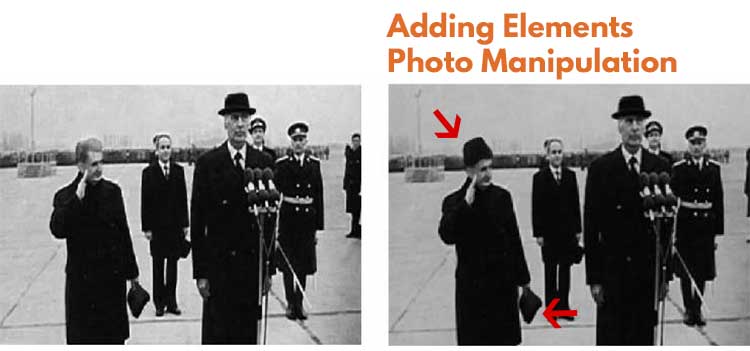
Fake photos in the news were common among dictators. Here, the Romanian president has two hats, one on the head and one in his hand. The hat on the head was later added out of vanity so that both presidents could have their heads covered.
The first Photoshop version was released in February 1990, so it's obvious that this unethical photo manipulation from 1979 was made using the manual cut and paste technique.
Doctored images were really common in the past and here is another example.
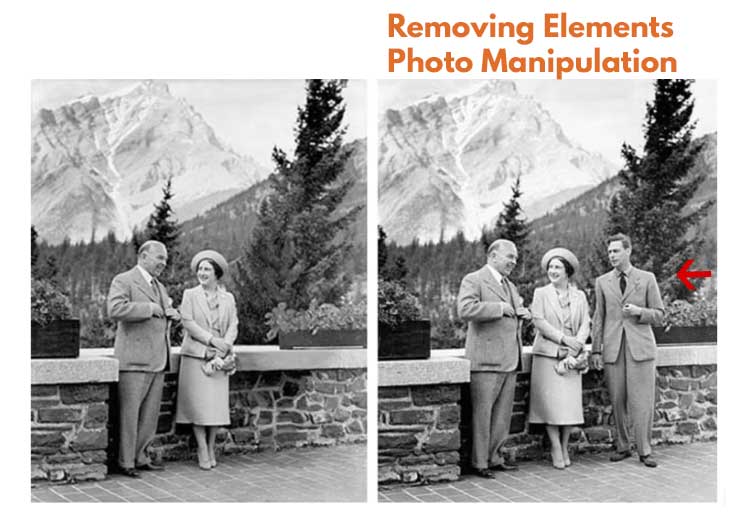
This seemingly manipulated image depicts Canadian Prime Minister William Lyon Mackenzie King alongside the Queen Mother, sans King George VI. The omission of King George VI from the final photo suggests an attempt to enhance the perception of the Prime Minister's strength and charisma.
Misleading photos in the media have a smaller or bigger impact depending on the amount of editing that has been done. This one seems rather harmless but still. Nowadays, removing elements from photos is done using the Content-Aware Fill Photoshop tool but for this 1939 photograph manipulation, physical cut and paste and manual retouching where probably used.
2. Cloning to Alter the Authenticity of the Scene 👎
This political ad for George W. Bush, as he was running for President in March 2004, shows a sea of soldiers as a backdrop to a child holding a flag. This image was photoshopped by copying and pasting, from this original photograph, several soldiers to digitally remove Bush from the podium.
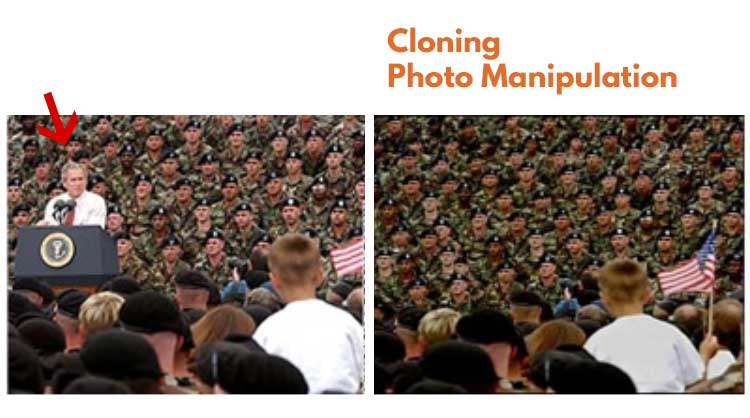
Later, campaign managers would admit to the altering of the image. The Bush campaign said that the ad would be re-edited and re-shipped to TV stations.
It is clear that the ethics of photojournalism were not respected and this was indeed a major photo edit.
3. Fabricating Scenes (Merging Two Photos Together) 👎
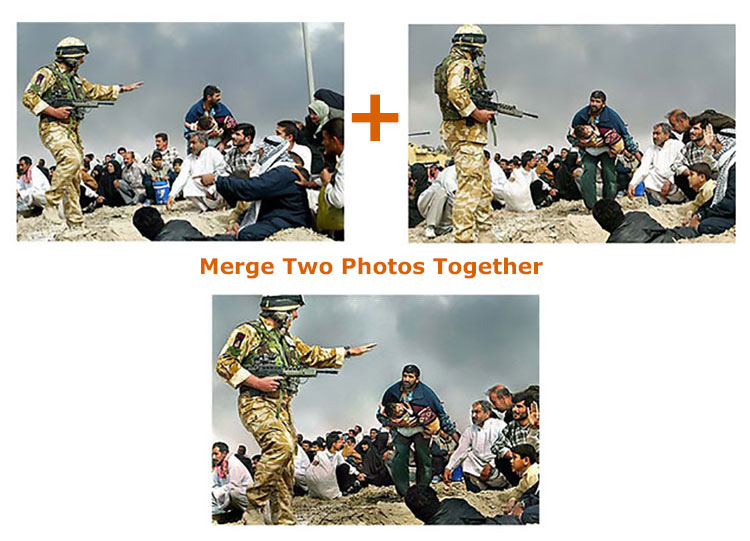
The top two photos were combined to create the third photo which was featured on the front page of the Los Angeles Times in 2003. After viewers commented that individuals in the background seemed to appear more than once, the photographs creator, Brian Walski, admitted to editing the photos together to improve the composition.
Once again, the photography ethics were disregarded in this image.
Brian Walski was a staff photographer for the Los Angeles Times and a 30-year veteran of the news business. And, after admitting to altering the news photograph to "improve" the composition, he was fired for not following the ethics of photojournalism .
4. Cropping for Altering the Context 👎
Stepan Rudik, winner of the 3rd prize story in Sports Features, was disqualified from the World Press Photo contest in 2010 for violating the rules by removing an element from one of the original photographs. After requesting RAW-files of the series from him, it became clear that an element had been removed from one of the original photographs.
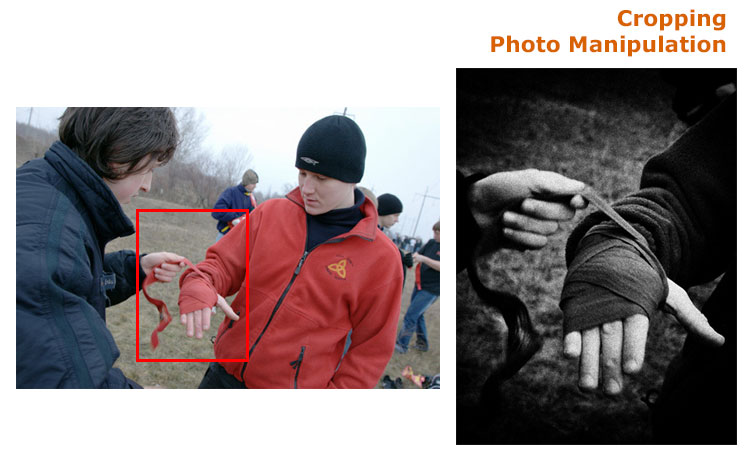
To make the scene more dramatic, the photographer used Photoshop (most probably) to crop the photo, to apply black and white color tones, to add a vignette, etc. These kinds of photos taken out of context are not acceptable when we talk about photojournalism and ethics.
5. Distorting Proportions Photo Manipulation 👎
Another case involved a National Geographic cover from 1982, where the pyramids of Giza were digitally repositioned to fit the vertical cover format.
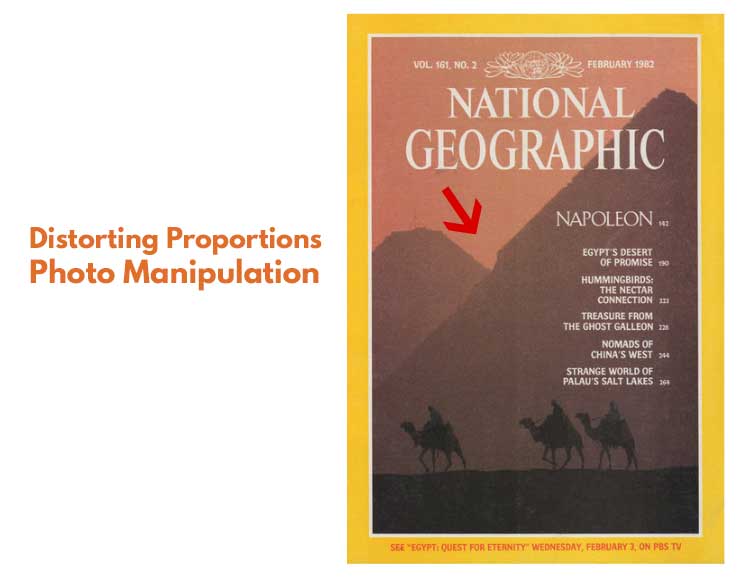
Now anyone can make Fake Magazine Covers using their photos for personal projects.
Although the National Geographic magazin cover manipulation was purely for layout purposes, it raised questions about altering images to fit aesthetic needs over factual representation. The photo journalism photography must not alter the reality.
6. Change Facial Expressions or Parts of the Body to Modify the Emotional Impact of the Image 👎
With the help of the AI advanced image processing technology, anyone can edit facial expressions in images, including laughing, pouting, unhappy and smiling. Use the Photoshop neural filters or AI image editing software.
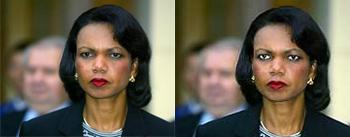
Another doctored image example is this 2005 photo in USA Today of former US Secretary of State, Condoleezza Rice.
After sharpening the photo for clarity, the editor brightened a portion of Rice’s face, giving her eyes an unnatural appearance. USA Today quickly admitted they had taken an Associated Press (AP) image of Dr. Rice by Mikhail Metzel and retouched the eyes.
7. Exaggerating Features (Smoke, Fire, etc.) to Dramatize the Situation Artificially 👎
Photoshopped images in the news are created with the intention of altering the facts and to add more drama.
The Adnan Hajj photographs controversy (also called Reutersgate) involves digitally manipulated photographs taken by Adnan Hajj, a Lebanese freelance photographer based in the Middle East, who had worked for Reuters over a period of more than ten years.
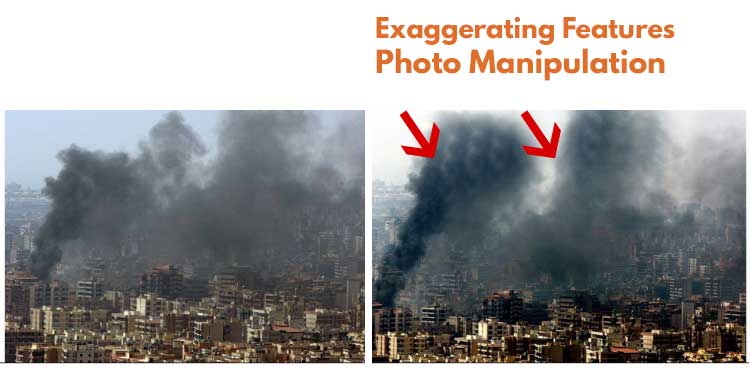
Hajj's photographs were presented as part of Reuters' news coverage of the 2006 Lebanon War. Reuters has admitted that at least two were significantly altered before being published. The manipulation exaggerated the smoke effect, amplifying the destruction's severity.
The frequent violation of war photography ethics, results in raised questions and also doubts about the ethical standards within this field.
Critics point out that in this doctored image, Hajj added an entire plume of smoke, duplicated several buildings, and showed a repeating pattern indicating that one plume of smoke was “cloned” several times using the Adobe Photoshop clone stamp.
8. Manipulating Colors to Significantly Change the Mood of the Photograph 👎
Faking photographs is a tempting practice for some photographers that want to impress the audience by providing fake news through manipulated pictures.
In November 1997, after 58 tourists were killed in a terrorist attack at the temple of Hatshepsut in Luxor Egypt, the Swiss tabloid Blick digitally altered a puddle of water to appear as blood flowing from the temple.
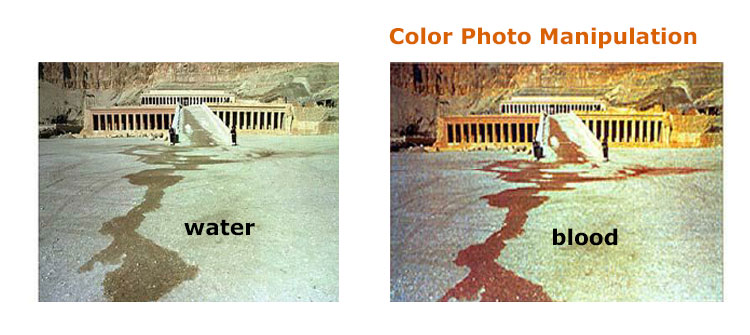
Among pictures that make you think wrong, this example is the most disturbing. The photo colorization technique was used to deceive the audience.
These examples reflect the ethical challenges in photojournalism, demonstrating the importance of maintaining integrity in photographic reporting.
⚡ AI Image Generator to Create Fake News
An AI deepfake image generator refers to a type of artificial intelligence technology that uses deep learning algorithms to create realistic and often deceptive images or videos.
AI Generated Images
So, basically a new era is here, an era where Photoshop is no longer the number one tool for faking images. The AI tools are now able to create fake images that mimic reality very well.
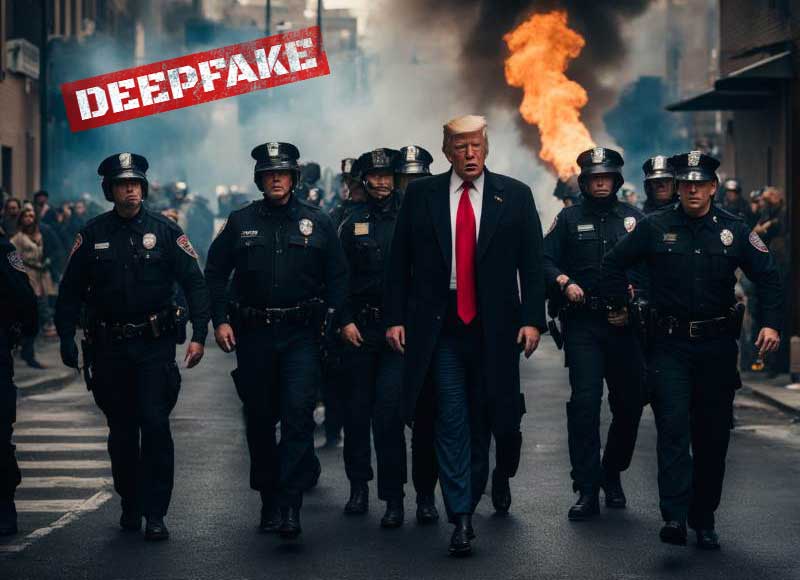
FAKE NEWS: "Donald Trump Leads Big March in Paris, Wants French Leader Out."
Generating images with AI tools like MockoFun is a quick process compared to manual photo manipulation in Photoshop. With AI you can create image to image effects, swap faces, generate images, etc.
Deep Face Swap
AI swap face is a technology that uses artificial intelligence to replace or exchange one person's face in an image or video with another person's face, creating a realistic and often entertaining visual result.
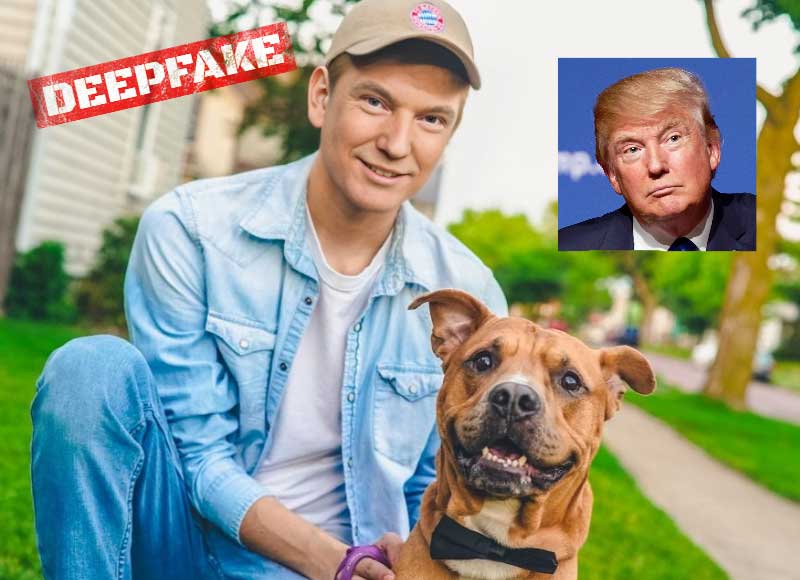
FAKE NEWS: "Donald Trump's Youthful Transformation: AI Nanotech from His Canine"
✔️ AI Pros in Photojournalism
AI plays a pivotal role in revolutionizing photojournalism by enhancing efficiency, accuracy, and storytelling capabilities. It aids in image analysis, automating tasks like tagging, sorting, and organizing vast photo archives.
AI-driven tools help detect and verify the authenticity of images, crucial in combating misinformation. Additionally, AI algorithms assist in editing, cropping, and enhancing photos, streamlining the production process. Moreover, AI-powered cameras can aid in capturing significant moments with improved precision and quality. Ultimately, AI empowers photojournalists with tools that augment their abilities, allowing for more impactful storytelling and faster dissemination of news.
AI in newsrooms streamlines tasks like data analysis, fact-checking, and content personalization, enhancing efficiency but also raising concerns about bias and ethical use.
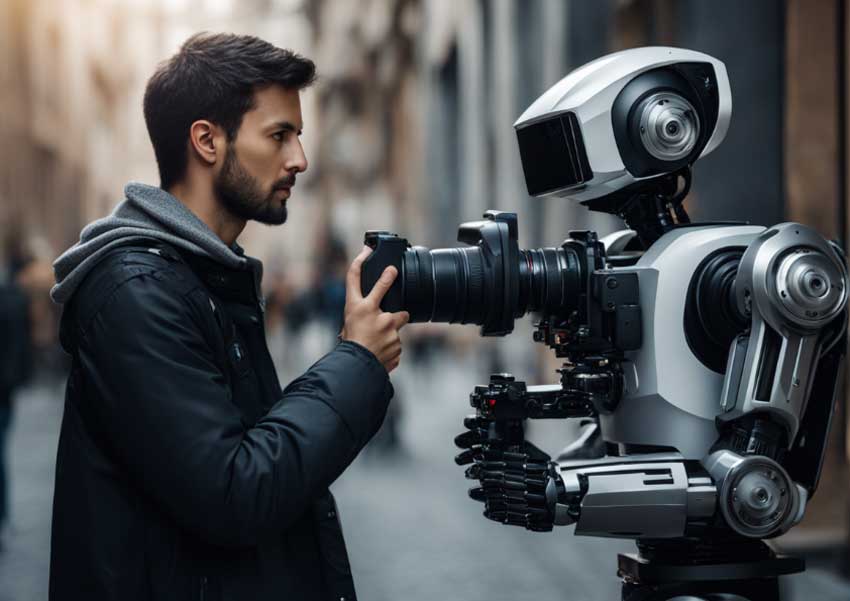
❌ AI Cons in Photojournalism
One significant concern regarding AI in photojournalism is the potential for manipulation and ethical challenges. As AI tools advance, there's a risk of altering images in ways that deceive or misrepresent reality. Deepfake technology, for instance, can fabricate entirely false visual narratives, undermining trust in journalistic integrity.
Moreover, reliance on AI for tasks like image selection or editing might inadvertently introduce biases, shaping the narrative in unintended ways. The danger lies in the misuse or misinterpretation of AI-generated content, potentially distorting the truth and eroding the credibility of journalistic storytelling. Vigilance and ethical guidelines are essential to navigate these risks and uphold the integrity of photojournalism in the AI era.
Types of Photojournalism
Photojournalism includes various types, each serving a specific purpose in storytelling. Here are the main types of photojournalism:
- Spot News Photojournalism: Focuses on capturing immediate, unexpected, or breaking news events (accidents, natural disasters, protests, or sudden incidents) as they unfold.
- News Photojournalism: Focuses on a broader range of news-related photography, including both immediate and planned events.
- Feature Photojournalism: Tells stories through images that highlight human interest, cultural aspects, daily life, or unique events, providing a deeper perspective beyond immediate news.
- Sports Photojournalism: Documents sports events, capturing the intensity, emotions, and key moments in various sports competitions.
- Portrait Photojournalism: Concentrates on individuals or groups, showcasing their emotions, personalities, and stories within a single frame.
- Environmental Photojournalism: Centers on environmental issues, aiming to raise awareness about nature, conservation efforts, climate change, and the impact of human activities on the environment.
- Conflict/War Photojournalism: Involves documenting conflicts, wars, and their aftermaths, often portraying the harsh realities and human suffering in these situations.
- Travel Photojournalism: Focuses on capturing diverse cultures, landscapes, and experiences from around the world, often aiming to evoke a sense of place and cultural diversity.
- Reportage Photojournalism: Focuses on reporting or covering specific events or stories as they unfold in real-time.
- Documentary Photojournalism. Focuses on telling a comprehensive story by documenting a subject or issue over an extended period.
The photography ethics apply to all the types of photography that are related to photojournalism like: sports photography, travel photography, conservation photography, ethnographic photography, social photography, war photography, news photography, reportage photography, documentary photography, etc. A good photo reportage is not only about capturing the best scene but also about respecting the ethics in each and every situation.
⚡ Laws of Photojournalism
Photojournalism is primarily guided by photojournalism ethics and industry standards rather than specific laws in many countries.
However, legal considerations are still crucial, and photojournalists must operate within the bounds of existing laws. Key legal aspects related to photojournalism ethics and photography laws include:
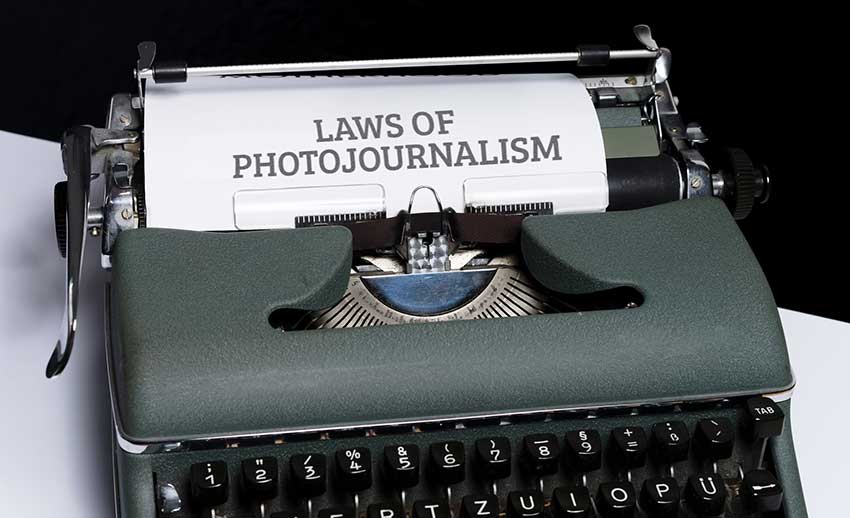
- Privacy Laws: Photographers must be aware of privacy laws, which vary by jurisdiction. Taking photographs of individuals in private spaces without their consent may lead to legal consequences. Additionally, the use of intrusive surveillance equipment may be regulated.
- Defamation Laws: If a photojournalist publishes false information that harms the reputation of an individual or organization, they may be subject to defamation laws. This includes situations where a photograph is used in a way that misrepresents facts or conveys a false narrative.
- Intellectual Property Laws: Photojournalists, as creators, have rights to their work under intellectual property laws. Others cannot use or reproduce their photographs without permission. However, there are exceptions, such as fair use, for reporting and commentary.
- Trespassing Laws: Accessing private property without permission may constitute trespassing. Photojournalists should be mindful of property rights and obtain necessary permissions when applicable.
- Copyright Laws: While copyright generally protects the creator's rights, in some cases, images taken in public spaces may be subject to different rules. Copyright laws vary, and photojournalists need to understand them to protect their work.
- Laws Related to Sensitive Content: There may be laws regulating the depiction of certain sensitive subjects, such as crime scenes, accidents, or children. Photojournalists should be aware of any legal restrictions in their jurisdiction.
- Press Freedom Laws: Some countries have laws protecting press freedom, ensuring that journalists can work without undue interference. Understanding and advocating for press freedom is crucial for photojournalists.
It's important to note that legal considerations can vary significantly between countries and regions. Photojournalists should stay informed about the laws relevant to their location and seek legal advice when necessary. Adhering to ethical guidelines and respecting the rights and dignity of subjects are fundamental principles that complement legal responsibilities in photojournalism.
⚡ How to Become a Photojournalist
Learning to be a photojournalist starts with education.
Obtain a bachelor's degree in photography, photojournalism, journalism, etc. or take relevant courses. Master the technical aspects of photography, including composition, lighting, exposure, and post-processing. Learn how to tell a compelling story through your pictures. Understand the importance of context and narrative in visual storytelling.
But it's not just about taking good photos. You've got to know some important rules about being fair and honest. Following the photojournalism ethics presented in our article helps you capture real moments in a respectful and meaningful way. So, grab your camera, practice lots, and remember to tell stories that matter with heart and honesty!
Once you have all of these skills, build a portfolio and apply for internships at newspapers, magazines, online publications, or media outlets. Or, you can start a freelance career by contributing to local publications or online platforms. Respect the photography ethics at all times to maintain your reputation.
Photosjournalism and Ethics: Conclusion
It's imperative to reflect on the power and responsibility that come with the ability to manipulate digital images. Photojournalists must navigate the fine line between ethical enhancement and distortion, bearing in mind that the trust of the public is their most valuable asset.
Students and professionals alike must strive to maintain the integrity of their work, ensuring that the pursuit of truth remains untainted by digital deception. Luckily, the “Photojournalism Ethics and The Role of Photojournalists in Portraying Truth” topic has been receiving more and more attention, and many students research it in their theses.
Photojournalists carry the weighty responsibility of being the public's eyes, often in places where most cannot venture. Their lens captures reality, which is then trusted to narrate the truth without words. This trust is sacred. It is built on the belief that the images presented are untainted by personal bias or digital manipulation, allowing the public to witness the world as it is.
So, faking photographs is out of the question!
Square Symbol
Amazing Christmas Inspired Photoshop Text Tutorials


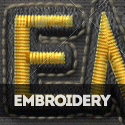

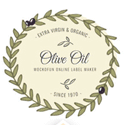

No comment(s) for "Photojournalism and Ethics"